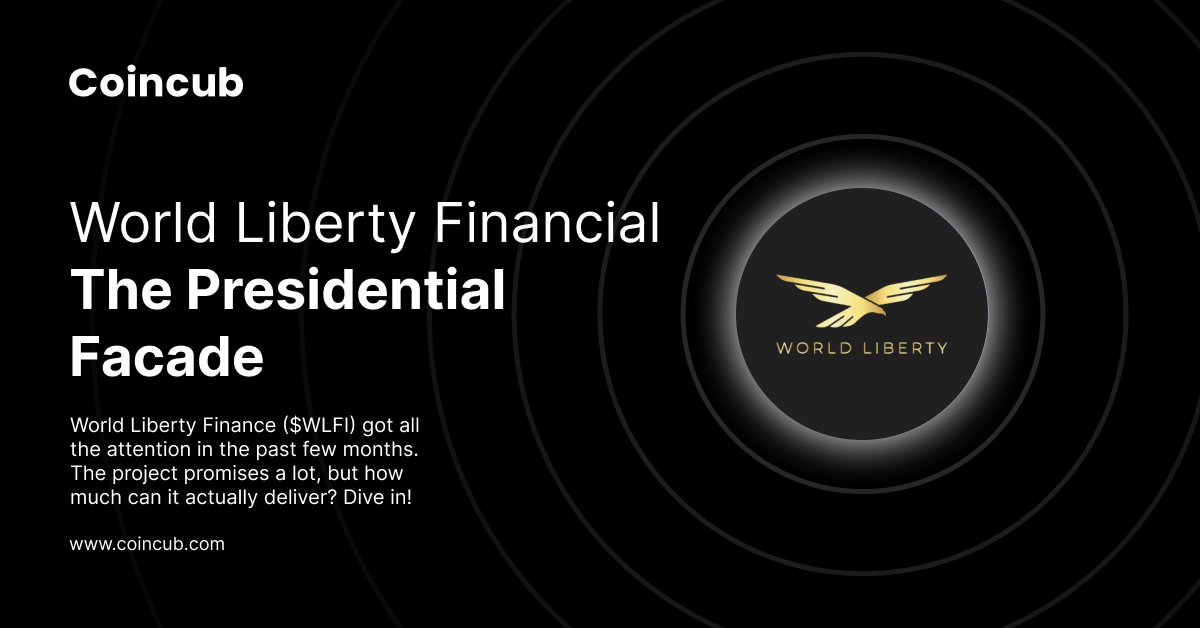World Liberty Financial: The Presidential Facade

This cycle has been more interesting than anyone would’ve anticipated. Bitcoin becoming a strategic reserve asset for leading economies; celebrities scamming their own followers; the US president and the first lady launching their own memecoins. It couldn’t get crazier even if we wanted to – but wait, there’s more. The Trump family launched a presale for a token that will power a whole ecosystem on Ethereum. Their goal? Fronting the market as mass adoption continues. However, this was not just another presale. World Liberty Financial (WLFI) launched with a spectacle that drew headlines. The Trump name is front and center – Donald J. Trump is listed as “Chief Crypto Advocate,” supported by his sons and even his youngest, Barron Trump, as “Web3 Ambassadors.” The project presents itself as Trump’s step into the crypto space, wrapped in the language of American values, financial freedom, and, obviously, as every other project, innovation.
But beyond the surface, WLFI raises immediate and serious concerns. There is no CTO, technical documentation, product demo, or open-source codebase. The few individuals listed with technical roles lack a history of building credible blockchain infrastructure. Some are freelancers without verifiable experience in leading or launching complex cryptosystems. And the worst thing is that we participated in the presale.
Despite the high-profile branding, the team’s qualifications – and the project’s actual foundation – remain unclear. Interviews with industry professionals reveal unfamiliar names and some questionable claims. This investigation examines the people behind WLFI, their backgrounds, and the warning signs that suggest this may be less of a legitimate Web3 initiative and more of a hollow venture using political recognition to attract capital and attention. This is the dark side of crypto, and it looks like the POTUS made a mistake.
The First Impression: Hype Over Value
At first glance, the team behind World Liberty Financial appears impressive. However, there is no indication that they have professional or technical experience in blockchain, crypto, or financial infrastructure – especially the Trumps.

Their involvement seems more about hype than value. Public records, speeches, and media appearances show no prior engagement with cryptocurrency beyond licensing Trump’s name for NFT projects. Even among supporters of crypto-friendly policies, there is skepticism about how these roles meaningfully contribute to WLFI’s development or direction.
Chase Herro – WLFI’s Hero?
Of even greater concern is the figure positioned more centrally in the project’s formation: Chase Herro. A 39-year-old entrepreneur who made headlines – not for building obviously – Herro has no proven track record in building crypto platforms. According to a report by Financial Post, he is unknown to crypto investors but has previously been linked to a token that dropped 96% after being promoted on Logan Paul’s podcast – the latter being charged with fraud in 2022, btw. In 2018, Herro publicly described himself as “the dirtbag of the internet” and said regulators should “kick heads like me out.”
While the Trump name draws attention, Herro appears to be the driving force behind WLFI, and that’s concerning. His past statements, failed ventures, and lack of industry recognition cast serious doubt on the credibility of the leadership team. For a project claiming to reshape the future of finance, WLFI possesses nothing. In other words, it is a big facade built solely on hype.
The Founding Team’s Background
Moving on, WLFI lacks the one thing every credible crypto project needs, and that’s a qualified technical team. Despite its ambitious rhetoric, the project has no listed Chief Technology Officer and no development roadmap. These elements are the bare minimum a project needs to even function, let alone present itself as the future of finance. Instead, it relies on the hype built by the support Trump shows to the crypto industry and a team whose backgrounds are full of red flags. However, we must mention that the project has a Gold Paper – a branded version of a whitepaper. That’s all they are offering at the moment.
Octavian Lojnita & Zak Folkman – Can They Handle All the Traction?
Octavian Lojnita, labeled “Blockchain Lead,” is a freelance developer based in Constanța, Romania. His public resume shows past involvement with a Bitcoin casino project in Gibraltar. That experience is quite obviously not enough to lead a large-scale blockchain project. Additionally, considering the nature of WLFI, security-critical approaches are necessary, something Lojnita appears to have no experience on. Lojnita is listed on freelance platforms like Toptal and openly advertises paid consulting calls on LinkedIn. This hints that he is likely working project-to-project rather than being committed full-time to WLFI. For a project as big as World Liberty Financial, having a freelancer on your core team is a ticking time bomb.
Zak Folkman, another co-founder, appears to have transitioned from lifestyle content to crypto with no verifiable development background. According to sources familiar with the team, his most cited credential is having read the Ethereum whitepaper – haven’t we all, Zak? While enthusiasm and passion matters, technical credibility cannot be replaced by social media influence.
Other names listed in leadership or advisory roles also lack transparency:
- Corey Caplan is labeled “Head of Technical Strategy,” but there is no evidence of contributions to any WLFI codebase or protocol design.
- Rich Teo, a co-founder of Paxos, is listed as “Stablecoin & Payment Lead,” yet there is no public indication that he is actively involved.
Neither figure has commented on their participation, raising questions about whether their names were added for perceived legitimacy rather than actual involvement.
Without a capable technical team, WLFI appears structurally unfit to deliver on any of its promises. In a space where even well-resourced startups fail the vast majority of times, the absence of credible builders is not just a vulnerability – it’s a fundamental failure.
Justin Sun: The Founder of Tron is Advising WLFI
Another major red flag is Justin Sun joining the team of WLFI as an advisor. While Sun is best known as the founder of Tron, a top 10 cryptocurrency by market cap, his track record in crypto is far from good. Sun has faced legal and compliance issues in the United States over the past few years.
🦅☀️ Exciting Announcement! ☀️🦅
We’re honored to welcome @justinsuntron as an advisor to World Liberty Financial (WLFI)!
Justin is the founder of @TRONDAO, an advisor to @HTX_Global, and a supporter of @BitTorrent. A graduate of the University of Pennsylvania, he recently won… pic.twitter.com/wJD24nztab
— WLFI (@worldlibertyfi) November 26, 2024
In March 2023, the U.S. Securities and Exchange Commission (SEC) filed a lawsuit against Sun and his companies, alleging the unregistered offer and sale of securities related to the cryptocurrencies TRX and BTT. The SEC also accused Sun of orchestrating a scheme to artificially inflate the trading volume of TRX through extensive wash trading and of paying celebrities to promote TRX and BTT without disclosing their compensation. This case was directly connected to the Logan Paul fraud case as well, by the way.
Sun’s history is full of controversy. He has faced regulatory warnings from U.S. authorities for alleged market manipulation and unregistered securities offerings. Even his PR stunts, such as winning the Sotheby’s banana artwork auction, tend to generate spectacle rather than substance.
WLFI already suffers from a lack of credible leadership and transparency. Bringing in a polarizing figure like Sun may give the illusion of legitimacy to those who are not familiar with his past. However, it does not change the core concerns about the project’s direction and integrity.
For your information, in February 2025, the SEC and Sun jointly requested a 60-day stay in the proceedings to explore a potential resolution, indicating that negotiations were underway to settle the case.
What’s Missing: Red Flags in WLFI’s Structure
Beyond the names and titles, World Liberty Financial lacks the basic components expected of any legitimate crypto project. There is no economic model. No GitHub repository showcasing code development. And no smart contract audit or security documentation.
These issues are not minor. In the crypto space, transparency is fundamental. Projects typically publish their code, engage with developer communities, and open their design to scrutiny. WLFI has done none of this. Even if the project isn’t open source, which is totally fine, it must have some sort of technical backing. There is no indication that any part of the system, including wallet infrastructure, smart contracts, stablecoin mechanics, is operational or even under construction.
Tokenomics are messy at the moment as there is no clear number or distribution of the supply yet. The economic model, governance structure, and distribution plan have not been shared with the public. Investors have no way of knowing how tokens will be allocated, who controls supply, or what mechanisms, if any, are in place to prevent manipulation or insider trading.
The Marketing Playbook
World Liberty Financial has leaned heavily on marketing to gain visibility. It offers little to no actual product development. But that’s alright; we are used to presales promising the world without any product or service in the crypto industry, right? Its public rollout focused on celebrity appeal, patriotic messaging, and design. Does anyone know what the platform will do? How will it work? Or even why it matters?
The Trump family name can only take you so far… Instead of developer updates or protocol research, WLFI’s public communications rely on visuals, slogans, and high-production videos designed to go viral. One YouTube video features dramatic music, bold catchphrases, and a heavy dose of nationalistic symbolism. This approach may win presidential elections and help you raise billions, but it will not build you a solid community and product.
This strategy mirrors other failed or scam projects that relied on personality-driven hype rather than value. It creates the illusion of momentum while masking the lack of a working product or credible architecture. The involvement of figures like Chase Herro further reinforces the concern that this is more about selling a brand than delivering innovation.
In the absence of a transparent development process, WLFI’s marketing push feels more like a campaign for attention than an effort to build long-term value. The project may be gaining followers – but not on the strength of its technology. On that note, followers that join a project because of hype usually ride the wave and leave as soon as TGE hits. Come back to this article when $WLFI drops.
WLFI: A High Risk High Reward Play?
Flashy launch, celebrity endorsements, vague promises, and no verifiable product – does this ring a bell? For retail investors, these are several of the classic warning signs seen in token rugs. These are not just early-stage challenges. If anything, these are not challenges at all. They are a huge plus for the project in terms of community building. But how is the project going to build upon that community when it has literally nothing to offer?
If tokens are issued without transparency around distribution or utility, early buyers risk being left with assets that hold no value or function. And given Chase Herro’s track record, with one project collapsing after an influencer-driven promotion and suffering a major hack, the risks aren’t hypothetical.
Crypto markets have matured since the ICO boom of 2017, but WLFI appears to be recycling the same tactics. Any 2017 OGs here? Do you remember the “branding to build momentum” tactics? With the added volatility of political affiliation, the stakes are even higher. If WLFI follows the same trajectory as Herro’s past ventures, investors may once again be left holding the cost of someone else’s marketing experiment. Despite having this many red flags, WLFI has been purchasing millions of dollars of different cryptocurrencies in the past few months. Cryptocurrencies bought by the World Liberty Financial Foundation include Ethereum, Bitcoin, Chainlink, Tron, Aave, and Ethena.
To commemorate the inauguration of Donald J. Trump as the 47th President of the United States, $WLFI is proud to announce the following strategic purchases today:
$47,000,000 ETH
$47,000,000 wBTC
$4,700,000 Aave
$4,700,000 LINK
$4,700,000 TRX
$4,700,000 ENAExcited for the…
— WLFI (@worldlibertyfi) January 20, 2025
USD1 – World Liberty Financial Stablecoin
Just a week ago, WLFI announced that it is entering the stablecoin arena with the launch of USD1, a dollar-pegged digital asset aimed at institutional adoption. The project positions USD1 as a regulated and conservative alternative to algorithmic and nontransparent stablecoins that have drawn negative press attention in recent years.
USD1 is marketed as being 100% backed by short-term U.S. Treasuries, cash, and dollar-equivalent deposits. According to WLFI, reserves will be custodied by BitGo, a regulated and insured custodian used by thousands of institutional players. Regular third-party audits are promised to ensure transparency, and BitGo Prime will provide liquidity and brokerage support.
The token will initially launch on Ethereum and BNB Smart Chain, with plans to expand to other ecosystems. WLFI claims USD1’s appeal lies in its simplicity, refraining from complex yield schemes for a “stability-first” approach meant to satisfy compliance-minded institutions. It sounds convincing but we can’t come to conclusions without seeing how it performs when it joins the market. The elements for WLFI to be a successful project are there, but the incompetent team, as well as the nontransparent approach say otherwise.
Meet USD1 — the stablecoin your portfolio’s been waiting for.
Built for institutions and retail alike. Backed by dollars. Custodied by BitGo.
No games. No gimmicks. Just real stability.https://t.co/vXPbZe0GPn— WLFI (@worldlibertyfi) March 25, 2025
Final Thoughts on The World Liberty Financial Project
World Liberty Financial presents itself as the project that will change digital finance forever. It is backed by the President of the United States of America and the marketing is top tier. But beneath the surface, it lacks every fundamental pillar of a legitimate crypto project: technical leadership, transparency, infrastructure, and credibility.
The team is largely inexperienced, the product is nonexistent, and the marketing strategy leans on fame rather than function. With no clear token model and a questionable track record behind its leading figure, WLFI shows all the signs of a venture built for visibility, not for longevity. KOLs and freelancers can help push memecoin communities, but relying on them for a project like World Liberty Financial is pure senselessness.
As history has shown, hype without value rarely ends well. For investors, this article should serve as a warning. Builders build, WLFI’s team does not. As always, do your own research. This should serve as an informative piece, not financial advice of any kind.




